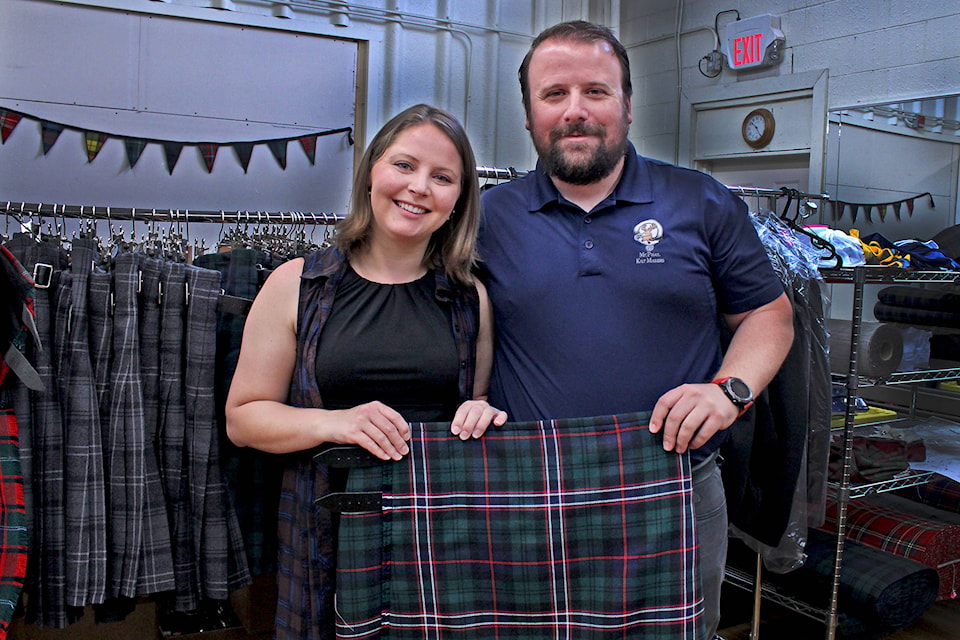When they first started making kilts just over a decade ago, Paul and Amanda McPhail never planned on turning their passion into a business, but that’s exactly what happened for the Penticton pair.
McPhail Kilt Makers, now located in the Cannery Trade Centre at 1475 Fairview Rd. after stints on Main Street and in their home, has made a name for itself internationally thanks to the high quality, hand-stitched kilts both Paul and Amanda produce. The two said while it may sound surprising, a good portion of their business comes from Scotland and other European-based retailers who appreciate the quality of their apparel.
“In Scotland, there’s a high demand for kilts right now when there wasn’t before. But now they’re running into the problem where there aren’t enough tailors to make the kilts,” said Amanda. “And here, our name is getting out there. We’ve been doing the Highland Games circuit. People heard about us and wanted to order from us. Then there were people who wanted to get wedding rentals, so it just kind of blossomed from there.”
Paul added, “We never envisioned what we would be today. We have people coming to see us in Penticton from all over.”
Paul said he made his first kilt for himself, with the help of the book titled The Art of Kilt Making, but the process was laborious due to the book’s wording and hand-drawn illustrations. He joked that they’ve managed to go from taking 400 hours on one kilt to being able to produce roughly five per week, with one kilt taking about three days to make.
READ MORE: Scottish Festival expected to draw over 2,000 Saturday
“We start with eight yards of single-width fabric on average, and all of the fabrics that we use are woven in Scotland, but the Welsh tartans we do have woven in Wales. They are 100 per cent pure new wool,” said Amanda. “We rip it to length. There is no standard length, they are all made to measure from the waist to mid-knee.”
“We put 20 to 25 hours into each kilt. Everything is 100 per cent hand-stitched so we don’t use sewing machines or anything like that,” said Paul.
A large part of their job, aside from physically constructing the kilts, is educating their customers on the tartans or designs available and just how a kilt should fit. They see a lot of people wearing ill-fitting kilts, or even wearing them backwards with the pleats in the front.
Amanda said there is a rich history behind how kilts look today compared to when they were first worn in Scotland at the end of the 1600s.
“It was more like a blanket and they would fold it and lay it on the ground, then they’d lay on it and wrap it around themselves,” said Amanda. “So Highlanders would wear that, and it progressed to where the top part of it was cumbersome so a tailor in Scotland cut the top part off and sewed all the pleats together. So that became the small kilt, which is very much-so like what they make today.”
The pair are happy to help inform anyone looking to learn more about kilts and said you can even design your own tartan online through the Government of Scotland’s National Tartan Registry website. They said this task is not an easy one though as the government must approve or deny the design, pending how close it resembles existing tartans, and then you can decide if you want to restrict it to prevent others from wearing it.
READ MORE: Penticton Scots Festival celebrates Canada’s 150th
Paul said while in the past it was a big faux pas to wear a tartan that was not associated with your family or clan, traditions have relaxed over the years. He explained that certain clans will still only wear their specific tartan, but companies, governments, districts and any other group or organization can create their own tartan so it gives people a lot of options in terms of style choice.
“Around the mid-1700s there was the Jacobite uprising in Scotland, so the British government decided they wanted troops up there watching the Jacobite activity. So they created the regiment called the Black Watch and wanted them to dress like the Highlanders, so they put them all in kilts,” said Amanda. “But because it was an army, they wanted them all in uniform. So they created the Black Watch tartan specifically for them, so when people saw them they knew. So they say that it sort of started using pattern to identify a group of people. So it started with the military and progressed from there. The bright tartan colours and patterns in that era were a symbol of Jacobite sympathies, and after they were defeated the government banned the wearing of these tartans.”
The McPhails will have a presence at the upcoming Penticton Scottish Festival on July 6.
Not only will the McPhail Kilt Makers have a tent selling merchandise and allowing festival goers to try on a traditional-style kilt for photos, the members of their family plan to compete in numerous events throughout the day including the bagpipe competitions and the heavy events.
For more information about McPhail Kilt Makers, visit www.mcphailkiltmakers.com.
